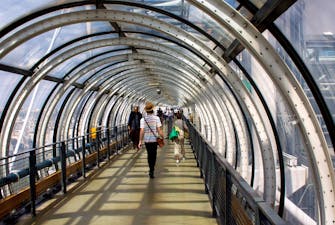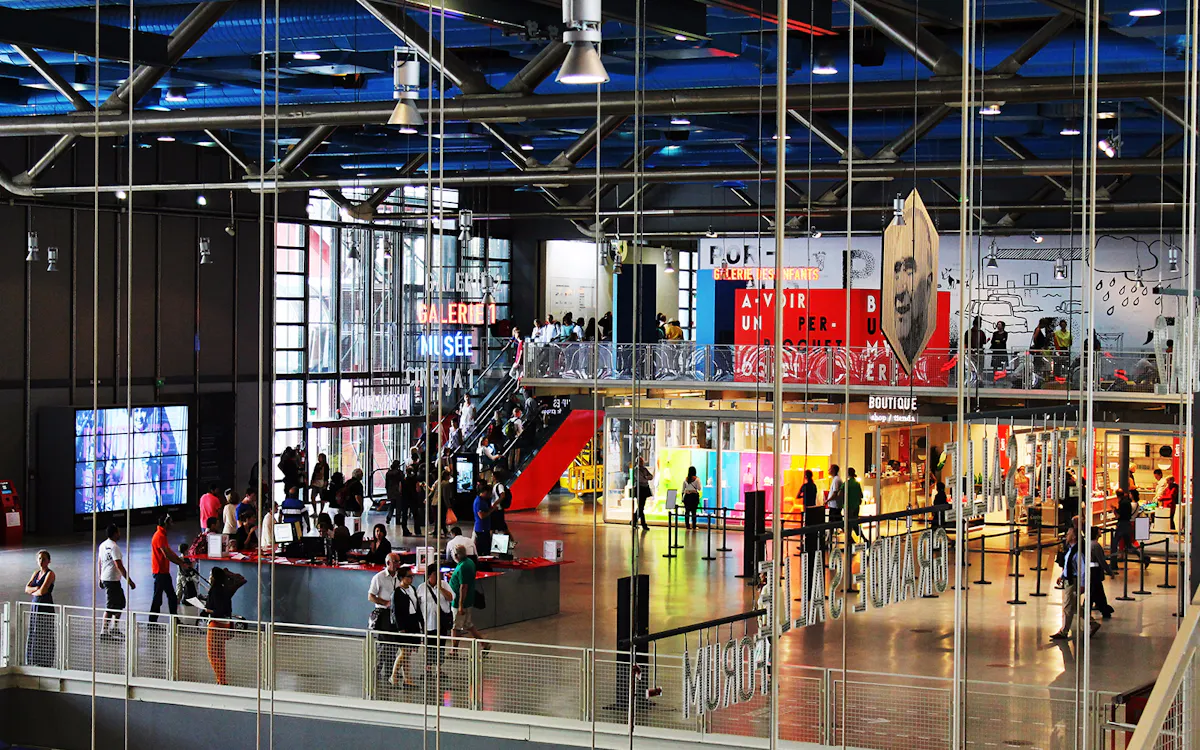A new-age architectural masterpiece which houses over 100,000 pieces of art, including the Musée National d’Art Moderne, Centre Pompidou is often considered to be a shrine dedicated to modern art. Ever since its inauguration in 1977, Centre Pompidou has solidified itself in the art world, and is world famous for its exhibitions, dance performances, cinemas and artifacts. Whether you’re into the world or not, this museum is a place you have to visit, simply because of its high-tech architecture and incredible visual appeal.
Centre Pompidou in a Nutshell



Centre Pompidou boasts the largest collection of modern and contemporary art in all of Europe. Along with the art exhibitions, Centre Pompidou also features a vast public library(Bibliothèque Publique d’Information), a research centre for acoustics and music and more. What’s more, the views from the top of Centre Pompidou are spectacular. Enjoy panoramic vistas of the Parisienne skyline and the landmark attractions including the Eiffel Tower, Notre Dame Cathedral and Sacre-Coeur Basilica.
Walking through the halls adorned with art, is an other-wordly feeling. Feel the artistic vibe and aura radiate over the venue as you explore the six major collections (detailed below) at Centre Pompidou. Featuring the works of many iconoclast art masters including Picasso, Pollock and more, the building itself is considered a piece of modern art. An eye-turner in medieval quarters, Centre Pompidou is recognized as one of the ‘Big Three’ museums of Paris and is the third most visited attraction in Paris attracting over 5.5 million visitors annually.
Must-see Exhibits
- The Violinist at the Window by Henri Matisse, 1918
- Fountain by Marcel Duchamp, 1917
- Hotel by Sophie Calle, 1981-1983
- Self-Portrait in Drag by Andy Warhol, 1986
- Outgrown by Thomas Hirschhorn, 2005
Priority Access Tickets to Centre Pompidou ✪
Price - € 14
Quick Jumplinks to Navigate the Guide
The Architecture of Centre Pompidou
Centre Pompidou is an ultra-contemporary artistic hub. And such a space, needs a brilliant design with zero clutter. It is with this intent that Renzo Piano, Richard Rogers and Gianfranco Franchini created an ‘evolving spatial diagram’. Based on this they designed the postmodern, high-tech building named after ex-French president, Georges Pompidou. Based on the ‘open-approach’ of architecture, they spread the museum over 7 levels to cover a staggering land area of 5 acres. Nearly 15,000 tons of steel lattices went into the Centre Pompidou, along with metal frames and glass facades. The building is simply one of the most impressive sights in Paris!

Designed to be fully accessible and open to the general public, upon first glance, the building looks like it’s been constructed inside-out. All the utilitarian features, including the pipes, plumbing, vents and cables are color coded and form part of the external facade, allowing the interiors to have maximum space. In fact, National Geographic proudly described Centre Pompidou as ‘Love at Second Sight’.
With its unique design , and abundant space which includes libraries, cinemas and exhibitions, the Centre Pompidou has attracted people from world over. The Pompidou Plaza is known for its presence of street performers, miniature carnivals and other cultural activities.
Centre Pompidou Tickets
- Walk through the interiors of one of the 20th centuries most high-profile architectural achievements.
- Peruse through Europe’s largest collection of modern and contemporary art from masters like Picasso, Max Ernst, Matisse, Man Ray and Francis Bacon and discover over 50,000 works of art.
- Head to the top and catch views of the Eiffel Tower, Notre Dame Cathedral, Sacre-Coeur basilica and other prominent structures.
- Centre Pompidou is also home to a vast public library, a research centre for acoustics and music and more.
- Explore the 6 different collections of Centre Pompidou - The Modern Art Collection, The Contemporary Art Collection, The Photography Collection, The Design Collection, The New Media Collection and The Cinema Collection.
The Centre Pompidou Collection
The Centre Pompidou Collection is the second largest collection of contemporary art in the world, and the largest in Europe. With over 50,000 works of art on display across the two top floors, the collection is among the most important in the world. Each collection within the Centre Pompidou is dedicated to specific era’s/style of art. Start on the top floor and take in the various isms: Fauvism, Expressionism, Cubism, Dadaism, and Surrealism, all laid out chronologically over the course of the 20th century.
1. The Modern Collection

Dedicated to artworks between 1905 & 1960’s, the modern collection consists of more than 7,000 works of art. Featuring works by over 1,500 artists, the Modern Art Collection on the 5th floor is a walk through history. See a collection that includes sets of major works by almost all the prominent figures of modern arts including Henri Matisse, Pablo Picasso, Constantin Brancusi, Robert Delaunay, Sonia Delaunay, Jean Arp, Wassily Kandinsky and more.
2. The Contemporary Collection

A collection dedicated to artists born after 1920, the Contemporary Collection features nearly 2,000 works by 750 artists. Study the new age paintings, sculptures, drawings, new media, photographs and more as you discover works of some of the most prominent artists including Andy Warhol, Francis Bacon, Mark Rothko, Yves Klein and several others.
3. The Collection of Photographs

The National Museum of Modern Art houses the largest collection of photographs in Europe. With over 40,000 prints and 60,000 negatives, the collection of photographs is made up of major historical ensembles. Today the collection presents a complete history of photography along with its diverse styles such as New Vision and Surrealism, while also showcasing works of renowned photographs including Man Ray, Brassai and Constantin Brancusi.
4. The Design Collection

Rich in prototypes, elements of design and exceptional pieces, the collection offers a constantly renewed reading of the history of design, from the masterpieces of the invention of modernity to pieces for a more forward-looking reflection. This collection brings together more than 5,000 pieces from designers all over the world.
5. The New Media Collection

One of the world’s first collection of new media works, the collection features 160 multimedia installations which can be used to view new media (videotapes, CD-Roms, soundtracks) dating from 1963 to the present day. Some of the iconic works for the collection include ‘New Skin’ by Doug Aitken, ‘Hors-Champs’ by Stan Douglas and ‘Foreign Body’ by Mona Hatoum.
6. The Cinema Collection

A collection dedicated to experimental filmmakers, films and installations made by visual artists, the Cinema Collection features over 1,300 works from all geographics and cultural backgrounds. From ‘Trip to the Moon’ by Georges Méliès(1902) to ‘Untitled’ by Trisha Donnelly(2015), the collection spans more than a century of experimental and artistic cinematic practices that developed on the margins of industrial cinema.
Spaces at the Centre Pompidou
Centre Pompidou is spread across seven levels, which can be divided into six different spaces. The Pompidou's permanent collection takes up a relatively small amount of the space when you consider this massive building's other features: temporary exhibition galleries, with a special wing for design and architecture; a highly regarded free reference library (there's often a queue of university students on Rue Renard waiting to get in); and the basement, which includes two cinemas, a theater, a dance space, and a small, free exhibition space. Here are some details about the main areas of Centre Pompidou:
Musee National d’Art Moderne
Housed on the 4th and 5th floors of the Centre Pompidou, Musee National d’Art Moderne features is the National Contemporary and Modern Art of France. Among the top 10 visited museums in the world, the museum showcases the largest collection of European Contemporary and Modern Art. With more than 50,000 works of art by 6,400 artists from 90 countries, the works include paintings, sculptures, drawings, prints, photographs, cinemas, new medias, and more, there’s plenty to see.
Level 5 is devoted to modern art from 1905 to 1960, including major works by Matisse, Modigliani, Marcel Duchamp, and Picasso. Over here, you’ll learn about the various -isms in art such as Fauvism, Expressionism, Cubism and Surrealism. Level 4 is dedicated to contemporary art from the '60s on, including video installations. Over here you’ll be able to see works including Pop Art, Nouveau Realisme and Conceptual Art from legendary artists such as Andy Warhol, Richard Hamilton, Dan Graham and Anish Kapoor.
Bibliothèque Publique d’Information
One of the best public libraries in the entire world, The Public Information Library of Paris is one of the hotspots for students and researchers in the city. Expect to see long queues here if you come during the day. Located on the 2nd and 3rd floors of Centre Pompidou, the library contains nearly 430.000 documents all of which are accessible to the public.
The library also has an entire section dedicated to audio visual collections, and another section dedicated to music. With cultural exhibitions and specialized journals, the Bibliothèque Publique d’Information is the perfect source of information for press, tourists, students, lecturers and researchers.
Galerie des Enfants
The Kids Gallery is a special exhibition area designed for children under the ages of 16. An open area dedicated to artistic development of children through observation and experimentation, the Galerie des Enfants presents two workshop-cum-exhibitions annually. Designed to be interactive, fun and childish, children are encouraged to explore the world of visual art, dance, design, music and more.
A special studio is designed for teenages between the ages of 13-16 where they can enjoy hands-on experience and exchanges with the creators. The studio covers all forms of contemporary arts including visual arts, dance, music, film, games, digital media, broadcasting, fashion, design and more. ‘La Fabrique’ at the Children’s Workshop is another highlight of this section. A fabrication laboratory, the tech here enables children to take an idea from a digital model, to a fabricated object. Usually restricted to industries, this experience is nothing short of magical!
Atelier Brancusi
Opposite the Centre Pompidou is an exact reconstruction of Constantin Brancusi’s studio. An artist of great pedigree, Brancusi worked in Paris for over 50 years and became one of the city’s most beloved art savants. During the 1920s, his studio became an exhibition space for his work, and today, the studio replica is presented as a museum space.
An interiorised space designed to isolate visitors from the street and piazza for a more immersive experience, Atelier Brancusi is a work of art in itself. Brancusi considered the relationship between sculptures and space to be of crucial importance, and the museum reflects upon this principle by carefully placing the artworks the way the artist had, nearly 50 years ago. Today the collection includes 137 sculptures, 87 baes, 41 drawings, 2 paintings and over 1,600 glass photographic plates and original prints.
Cinemas
Unlike most cinema houses, Centre Pompidou offers much more than the latest released. Throughout the year you can see various exhibitions and screenings, meet artists and creators, and analyse the works of the great master. Discover the video heritage of Centre Pompidou as you indulge in an evening of cinema and enjoy experimental cinema, new media creation, dance films, documentaries and more.
Please check the timings listed below for a brief understanding about the types of shows, and their key highlights.
Dining and Stores
There are two dining option you can choose from if you wish to dine within Centre Pompidou. The more famous, spectacular and luxurious one is Restaurant Georges. Known for its spectacular design, prestige cocktails and extravagant dinners, Georges is perfect for a romantic evening. Open between Wednesday & Monday from 12 PM to 2 PM, you must reserve a table here if you plan to eat.
If you’re looking for something more affordable, then head to the Mezzanine Cafe on Level 1. A quaint cafe overlooking the forum of Centre Pompidou, the place is open between Wednesday - Monday from 11 AM - 9 PM. No reservations are required.
You can also find bookshops on several floors of the Centre Pompidou that sell books on art, design, architecture and photography. Additionally, the Centre Pompidou Store at the ground floor is ideal if you’re looking to purchase any designer items, souvenirs and stationery.
Top 5 Must-See Exhibits at Centre Pompidou
1. The Violinist at the Window by Henri Matisse, 1918
Painted in Matisse’s signature style, The Violinist at the Window is often interpreted as a self-portrait. The theme of the painting is Music, and the painting uses a lot of elements of music iconography in its composition. In a continuity of style with the works that precede it, here he returns to the motif of the window and again uses black, though with new colours that are less heavy.
2. Fountain by Marcel Duchamp, 1917
Arguably among the most famous urinal in history, the piece is viewed by many art historians and critics as a major landmark in 20th century art. Photographed by Alfred Stieglitz, the fountain is one of the quirky hallmarks of the contemporary art world.
3. Hotel by Sophie Calle, 1981-1983
Based on an autobiographical stories, Calle’s work speaks louder than a 1000 words. The Hotel is a work of art which depicts how people who rent the hotel room leave the room empty when they’re not in it. By taking the role of a house-keeping lady, Sophie Calle examined for three weeks the traces of sleep and strangers intimacy in a secret transgression.
4. Self-Portrait in Drag by Andy Warhol, 1986
Andy Warhol is regarded as a pioneer of modern art forms, and his ‘Self Portrait in Drag’ series is no different. Drawing upon the worship of 1980s American stars, the polaroid series seeks to underline the performative nature of identity.
5. Outgrown by Thomas Hirschhorn, 2005
One of the more recent exhibits, Outgrown is made by using recycled materials. Created by supported of DIY aesthetics, the piece seeks to nurture a conversation around social and political issues.
Practical Information
Open Hours
• Centre Pompidou is open everyday between 11 AM & 10 PM from Wednesday to Monday. The exhibition areas close by 9 PM and last admission is at 7:30 PM.
• Bibliothèque Publique d’Information is closed on Tuesdays. Monday to Friday it is open between 12 PM and 10 PM. During weekends, and on public holidays it is open between 11 AM and 10 PM.
• The Galerie des Enfants is open between 11 AM & 7 PM from Wednesday to Monday during periods when an exhibition is programmed. The Atelier des Enfants provides activities for children aged 2 to 10 every Wednesday, Saturday and Sunday, and every day during the school holidays (zone C), except Tuesdays between 3 PM & 6 PM.
• Atelier Brancusi is open between 2 PM to 6 PM from Friday to Wednesday.
• Cinema Event Schedules:- Movie: Overview of the Museum’s film collection - One Wednesday a month at 7 PM; Video and After: Meeting with artists and art historians proposing screenings, conferences and discussions - One Monday a month at 7 PM; Dance Films: A multidisciplinary approach of dance film and their rich choreographic proposal - First Thursdays of each month at 7 PM; 40 Years of Documentary Films - Second Thursday of each month at 8 PM; Cinema Prospective: Explore the film production of contemporary artists - Last Thursday of each month at 8 PM.
Getting Here
• By Metro: Rambuteau (line 11), Hôtel de Ville (lines 1 and 11), Châtelet (lines 1, 4, 7, 11 and 14)
• By RER: Châtelet-les Halles (lines A, B and D)
• By Bus: 29, 38, 47, 75
• By Vélib: station no. 4020, opposite 27 Rue Quincampoix; station no. 3014, opposite 34 Rue Grenier Saint-Lazare, station no. 3010 at 46 Rue Beaubourg
• By Autolib: station at 204 Rue Saint-Martin; station at 36 Rue du Temple
• By Car: The Centre Pompidou car park entrance is at 31 Rue Beaubourg
Insider Tips, Tricks and Suggestions
- The first thing to do at the Centre Pompidou is to head to the reception desk, and find out the list of events, exhibitions and workshops planned for the day.
- The best way to explore the museum is from top to bottom. If you start your day early, you’re definitely going to bypass all the crowds at the Musee National d’Art Moderne. Then make your way to the lesser crowded areas as people begin coming in around noon.
- Visiting either in the morning or later in the evening is preferred to escape long lines. Reach at least half an hour before the opening time of 11 AM.
- All tickets to the Centre Pompidou include admission to the rooftop. Be sure to make your way to the top for stunning views of Paris.
- The Pompidou Plaza always has street performers including mimes, jugglers, clowns and during Spring hosts miniature carnivals. Be sure to keep an eye out for this on your visit to the Centre Pompidou.
- A key attraction near the vicinity of the Centre Pompidou is the Stravinsky Fountain. Located towards the south side of the centre, the fountain is a mechanical artwork featuring skeletons, hearts, clefs, and ruby-red lips. Perfect for photo-ops!
- Another place you have to check out, is the wall at the corner of Rue Clairvaux and Passage Brantome. Over here lies a bizzare mechanical brass-and-steel clock called Le Defenseur du Temps.
- For a truly immersive experience, we recommend going on guided tour. This tour will be held on Wednesdays and Thursdays at 7 PM, and on Saturdays and Sundays at 2 PM and 5 PM. There are other speciality tours you can indulge in depending on the museums agenda.
- Cameras and other recording equipment is not allowed at the museum space. If you’re planning to carry equipment, chances are you’re not going to be able to use it. However, cloakrooms are available at the venue which stay open between 11 AM and 9:50 PM.
- Planning a romantic evening at the rooftop restaurant ‘Georges’? Be sure to reserve a table in advance.
- If you want to spend no money on your visit to the museum then keep an eye out on the first Sunday of each month. Admission to the museum is free on these days.
The post All You Need To Know About The Eclectic Centre Pompidou in Paris appeared first on Headout Blog.
Article source here:Headout Blog

No comments:
Post a Comment